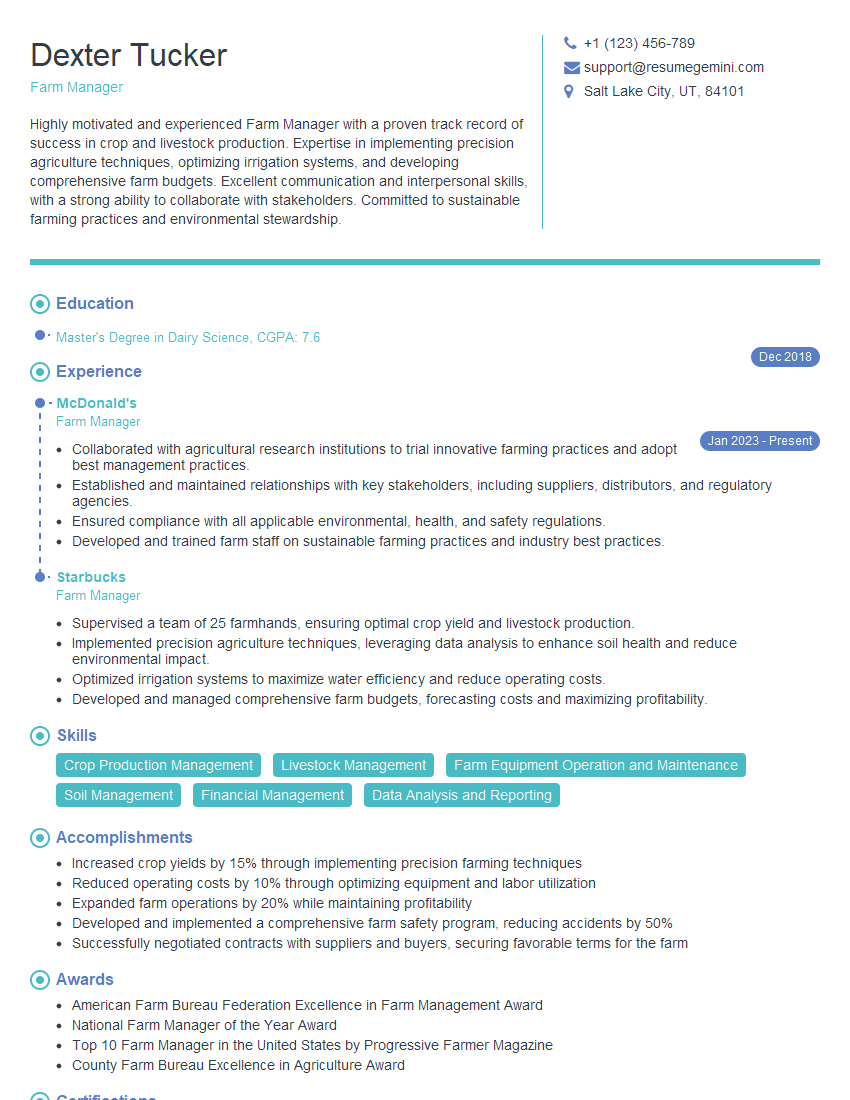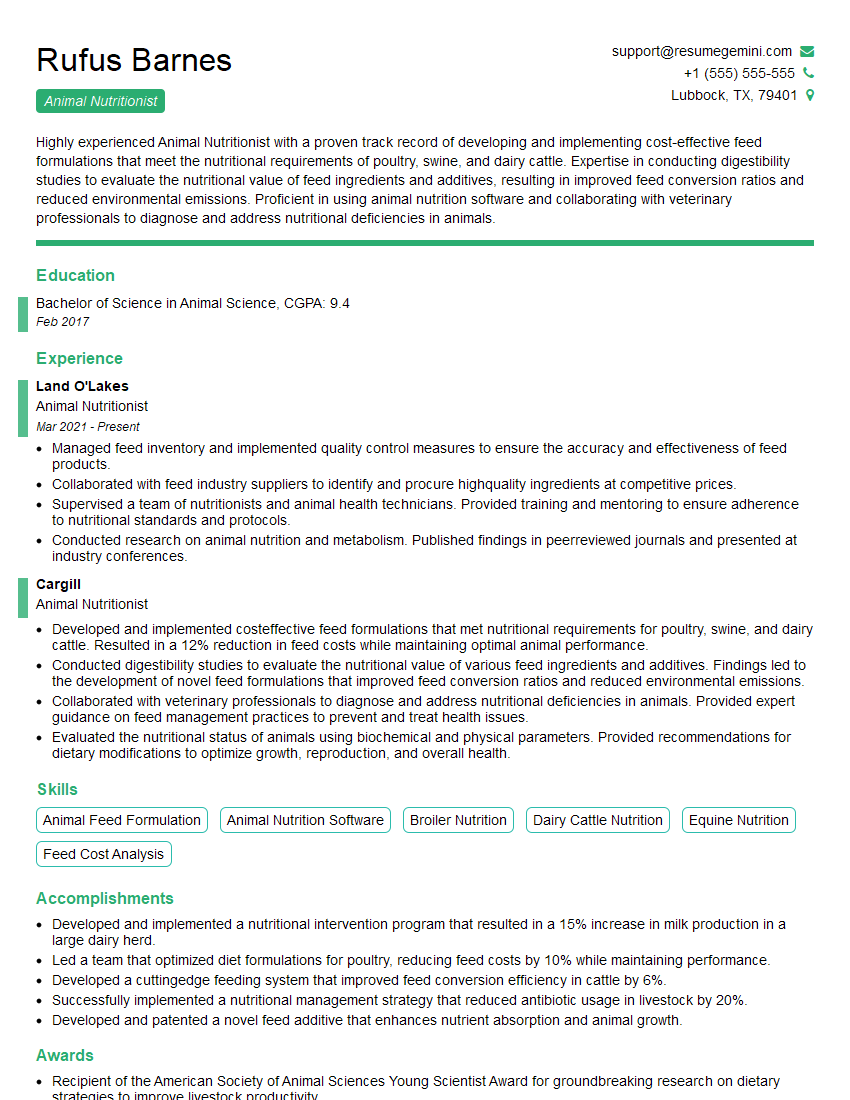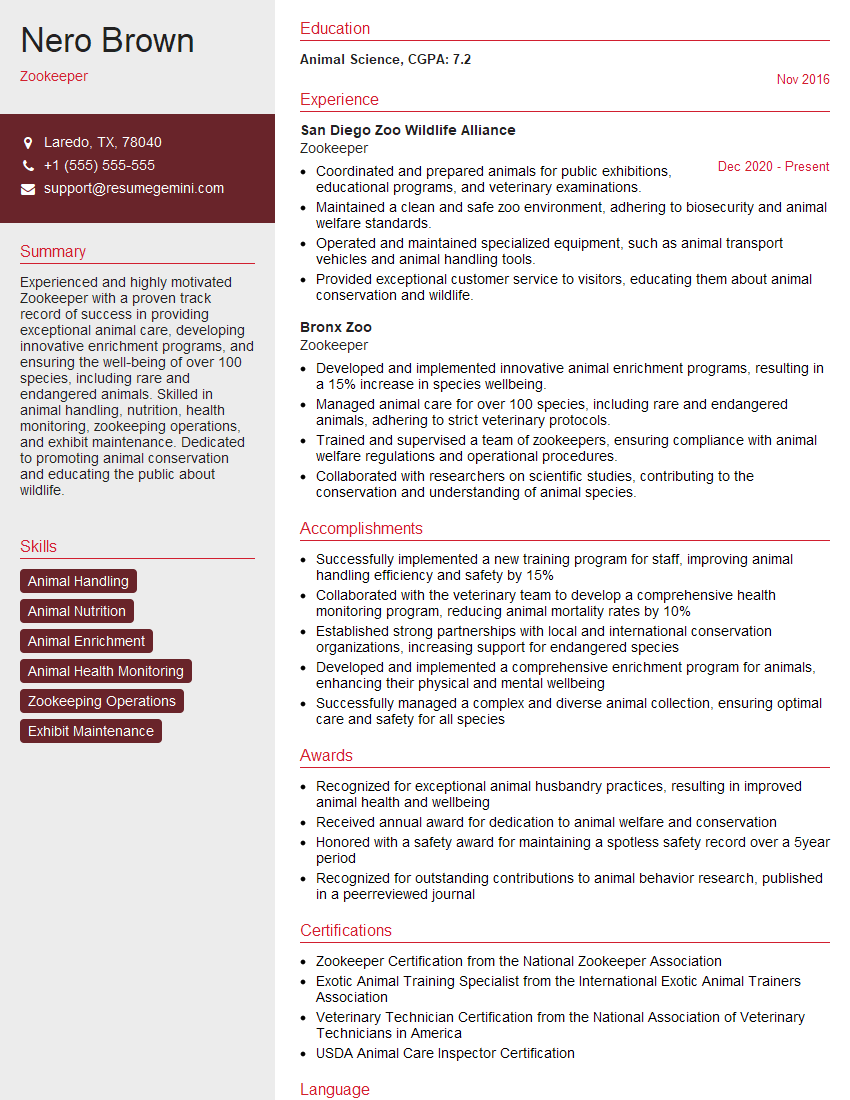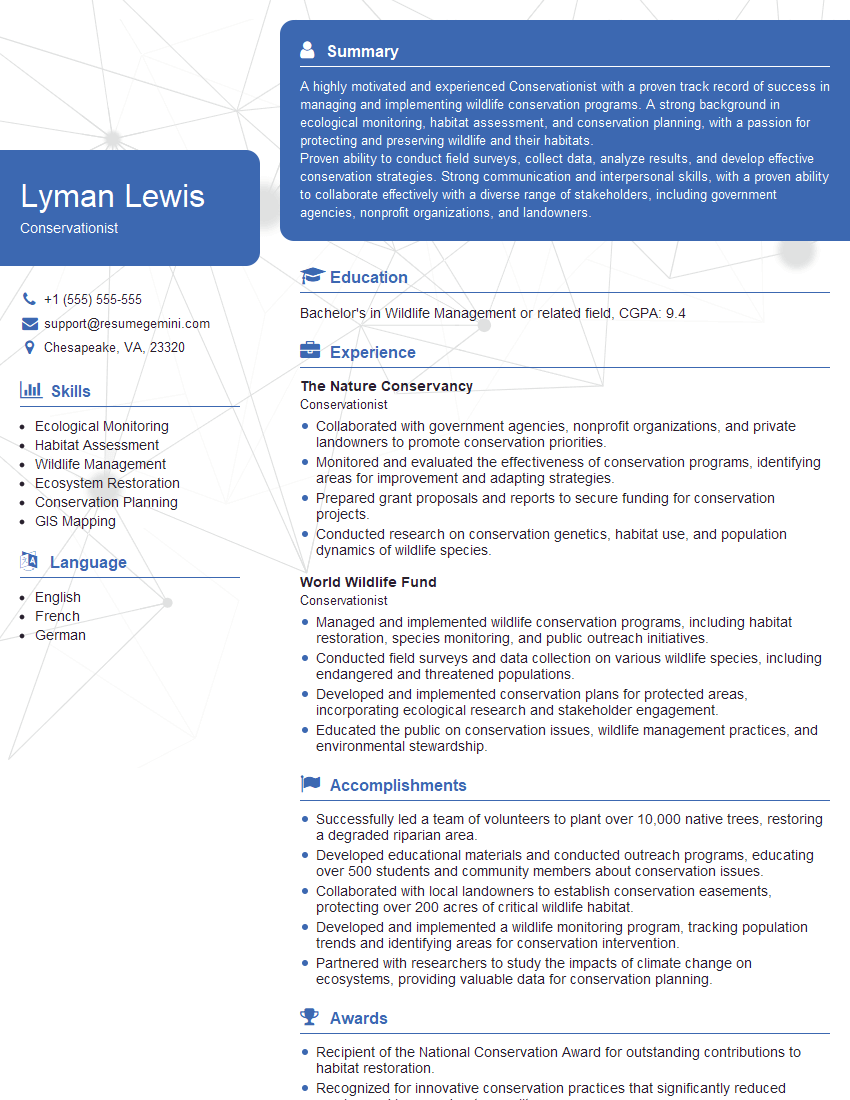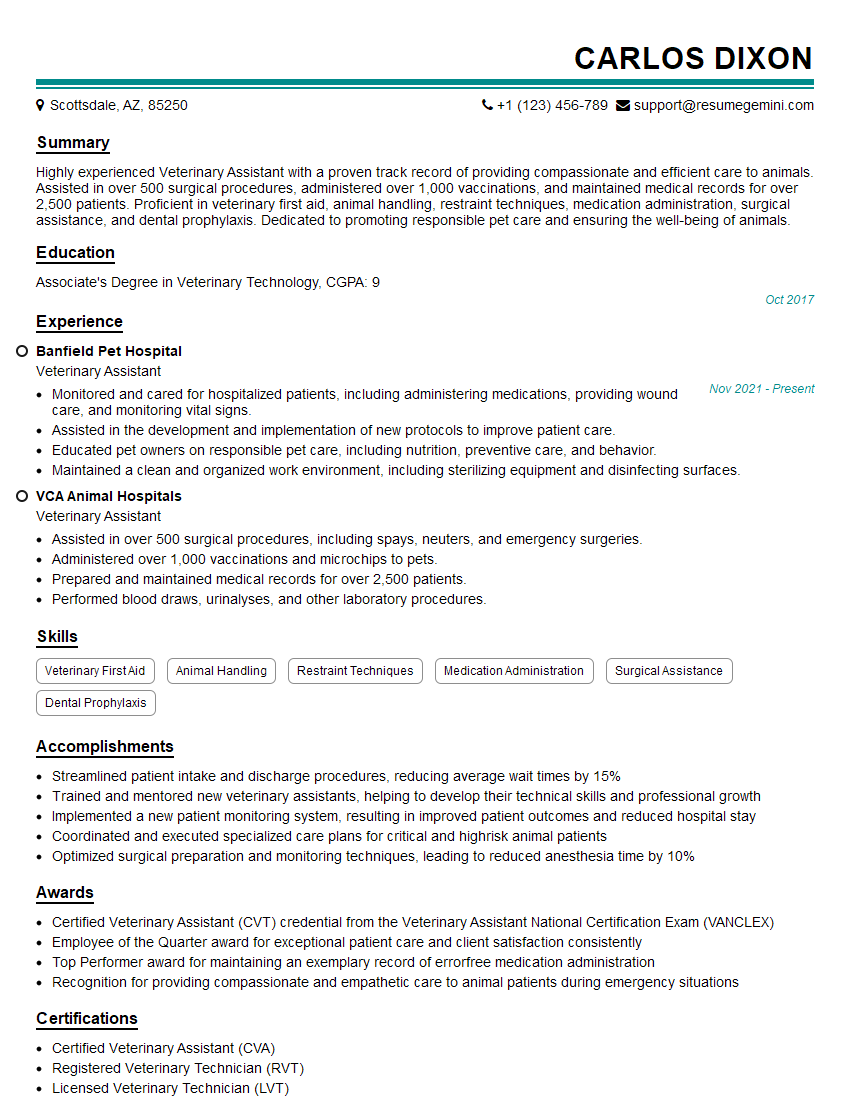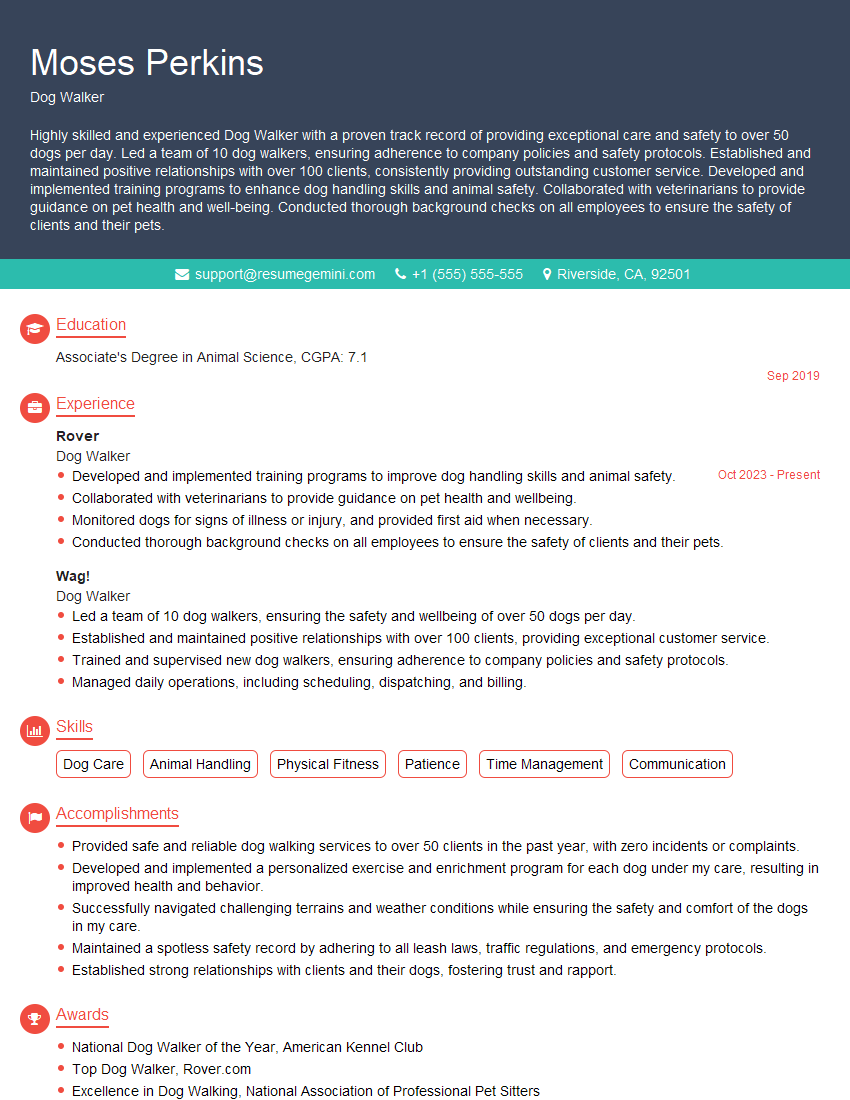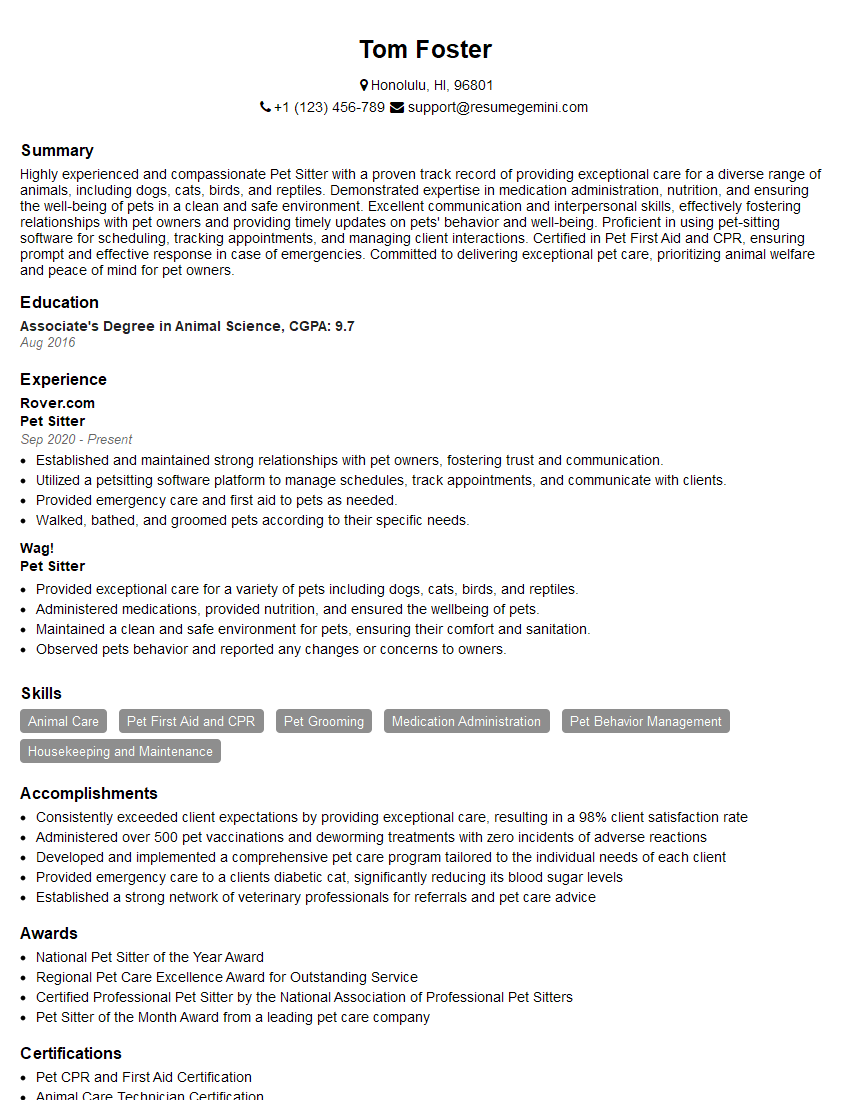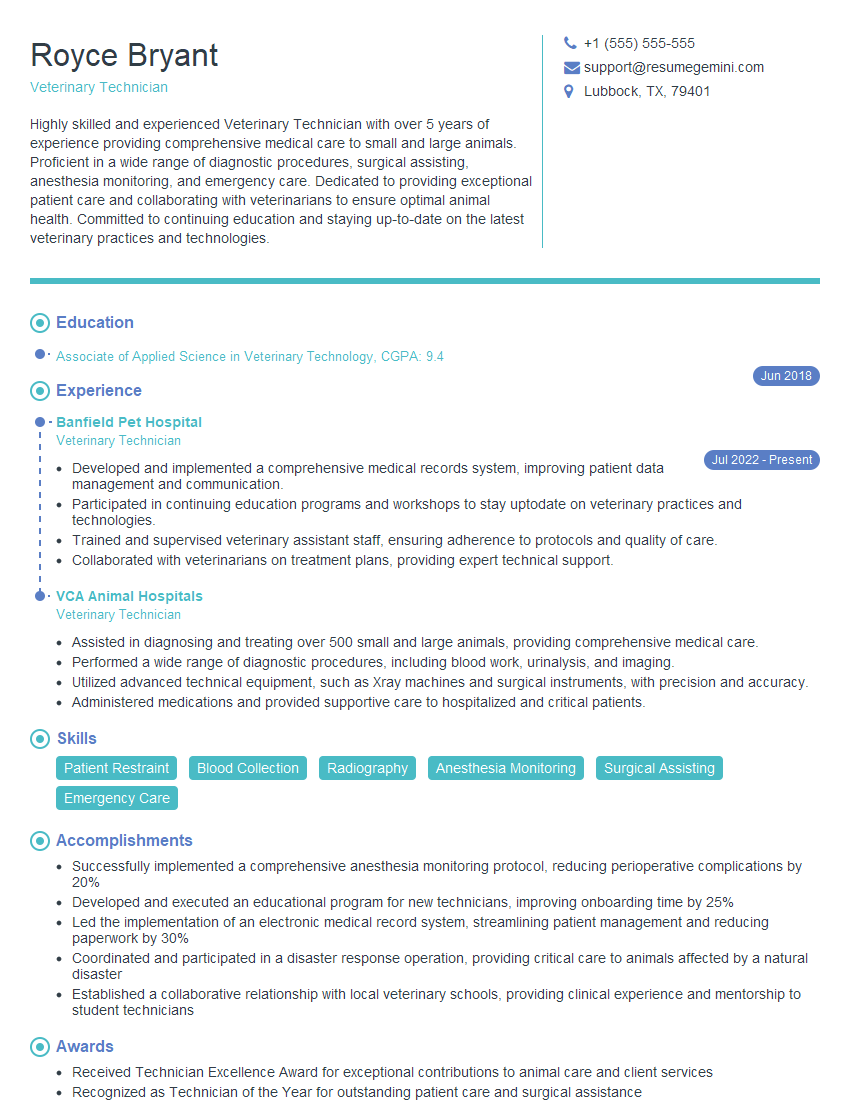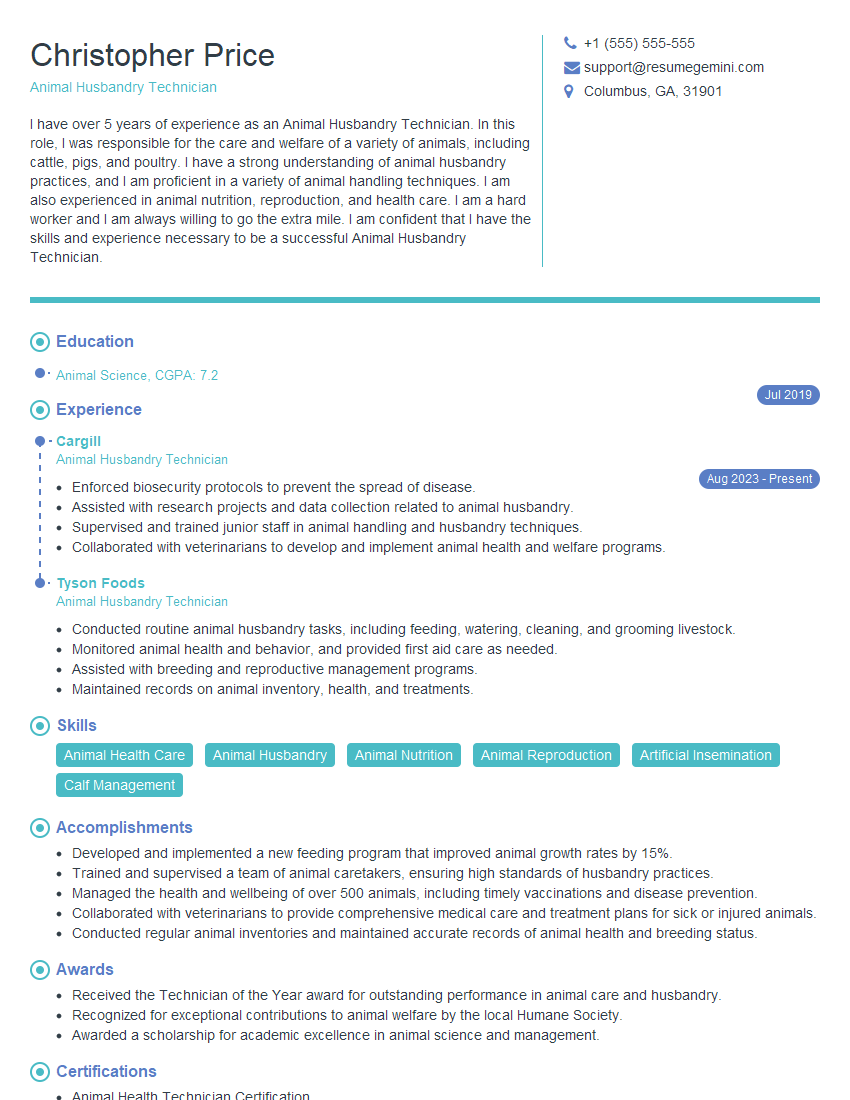Every successful interview starts with knowing what to expect. In this blog, we’ll take you through the top Feeding and Watering Animals interview questions, breaking them down with expert tips to help you deliver impactful answers. Step into your next interview fully prepared and ready to succeed.
Questions Asked in Feeding and Watering Animals Interview
Q 1. Describe the nutritional requirements of dairy cows.
Dairy cows have high nutritional needs to support their milk production. Their diet must be balanced to provide adequate energy, protein, minerals, and vitamins. Think of it like a high-performance athlete – they need fuel to perform at their peak.
Energy: This is crucial for milk production and maintaining body condition. It’s primarily supplied through forages like hay and silage, along with grains like corn. The amount of energy needed varies greatly depending on the cow’s lactation stage, breed, and body condition.
Protein: Essential for milk protein synthesis and overall growth. Sources include forages, grains, and protein supplements like soybean meal. The quality of protein, measured by its amino acid profile, is also important.
Minerals: Calcium and phosphorus are particularly critical for milk production and bone health. Other important minerals include magnesium, potassium, sodium, and trace minerals like copper, zinc, and selenium. These are often supplied through mineral supplements tailored to the cow’s needs.
Vitamins: Vitamins A, D, and E are particularly important for immune function and overall health. Deficiencies can negatively impact milk yield and reproductive performance.
Water: Access to clean, fresh water is crucial. Dehydration significantly reduces milk production and overall well-being.
Example: A high-producing Holstein cow in peak lactation might require a diet formulated to supply approximately 60-70% of its energy from forages, with the remaining energy coming from grains. Precise requirements vary depending on factors like milk yield and individual cow characteristics, necessitating regular monitoring and adjustments.
Q 2. Explain the process of preparing a balanced diet for poultry.
Preparing a balanced diet for poultry involves considering several key factors, much like creating a nutritious meal plan for humans. The precise formulation depends on factors like bird species (broiler, layer, etc.), age, and production goals (meat or egg production).
Energy Sources: Grains like corn and sorghum are the primary energy sources. They’re rich in carbohydrates that provide fuel for growth and egg production.
Protein Sources: Soybean meal, fishmeal, and meat and bone meal are common sources of protein necessary for muscle development and egg production. The level of protein needs to be carefully adjusted based on the bird’s age and growth stage.
Vitamins and Minerals: Poultry require a wide range of vitamins and minerals, which are often added to feed in premix form. Vitamins A, D, E, and K, along with calcium and phosphorus, are essential.
Amino Acids: Essential amino acids like methionine and lysine are particularly important, as they’re not produced by the bird itself and need to be included in the diet.
Fiber: A moderate amount of fiber helps with gut health and prevents digestive problems.
Process of Preparation: Formulating a balanced diet typically requires using feed formulation software or working with a nutritionist. They can calculate the correct ratios of ingredients to meet the specific nutritional requirements. Ingredients are then precisely mixed and processed, creating pellets or mash depending on the bird’s age and type.
Example: A commercial layer diet might consist of corn (major energy source), soybean meal (main protein source), limestone (calcium), and a vitamin-mineral premix. The precise percentages are carefully controlled to optimize egg production and shell quality.
Q 3. What are the signs of dehydration in horses?
Recognizing dehydration in horses is crucial for their well-being. Several signs can indicate a problem, and early detection is essential.
Obvious Signs:
- Dry mucous membranes: The gums and inside of the lips will feel dry and sticky rather than moist and pink.
- Sunken eyes: The eyes may appear slightly sunken into their sockets.
- Loss of skin elasticity (skin tent): If you pinch the skin on the neck, it should snap back quickly. In a dehydrated horse, the skin will remain tented for a moment.
- Decreased urine output: A reduction in the frequency and amount of urination is a major indicator.
- Lethargy and weakness: The horse might appear less energetic, weak, or reluctant to move.
Less Obvious Signs:
- Rapid pulse and breathing: The horse’s heart rate and respiratory rate may increase as the body tries to compensate for dehydration.
- Increased capillary refill time: Pressing on the gums should result in immediate return of the pink color. Delayed return indicates poor circulation, often associated with dehydration.
Important Note: Dehydration can be a symptom of various underlying conditions, so veterinary attention is crucial.
Q 4. How do you prevent feed contamination?
Preventing feed contamination is paramount to ensuring animal health and safety. Contamination can occur at various stages, from storage to feeding. A multi-pronged approach is needed.
Proper Storage:
- Clean and dry storage areas: Storage areas must be clean, dry, well-ventilated, and protected from pests (rodents, insects, birds).
- Use of sealed containers: Storing feed in sealed containers prevents moisture absorption and contamination by dust or other debris.
- FIFO (First-In, First-Out) system: This ensures older feed is used before newer feed, preventing spoilage.
During Feeding:
- Clean feeders and troughs: Regularly clean and disinfect feeders and troughs to prevent the buildup of bacteria, mold, and parasites.
- Protect from environmental contamination: Avoid feeding in areas exposed to rain, mud, or animal waste.
- Proper handling: Avoid contaminating feed with hands, tools, or other materials during feeding.
Pest Control:
- Regular inspections: Regularly check storage areas and feeding areas for signs of pest infestation.
- Implementing pest control measures: Use appropriate pest control methods to eliminate infestations.
Example: A farm might use rodent-proof containers for feed storage, regularly clean troughs, and employ a pest control program to prevent feed contamination. This combination of strategies minimizes the risks of health problems and financial losses associated with contaminated feed.
Q 5. What are the different methods of water delivery for livestock?
Livestock water delivery methods vary depending on factors like herd size, location, and budget. The goal is to ensure animals have consistent access to clean, fresh water.
Methods:
- Troughs: Simple and common, especially for smaller herds. Require regular cleaning to prevent contamination.
- Automatic waterers: These systems provide a continuous supply of water, reducing labor and ensuring consistent access. They can be nipple drinkers or bowl-type drinkers.
- Pumps and pipelines: For larger herds or operations with water sources distant from livestock. They can be very efficient, but require maintenance and monitoring.
- Water tanks: Often used in conjunction with other systems; can be gravity-fed or pumped.
Factors to Consider:
- Water quality: Water must be clean and free from contaminants.
- Accessibility: All animals must have easy access to water, especially young or weak animals.
- Water pressure: Adequate water pressure is essential for automatic waterers.
- Maintenance: Regular cleaning and maintenance are vital for all systems to prevent contamination and malfunction.
Example: A large dairy farm may use a pump and pipeline system to distribute water to multiple automatic waterers strategically placed throughout the pasture, ensuring all cows have convenient access to fresh water.
Q 6. How do you monitor feed intake in a group of animals?
Monitoring feed intake in a group of animals isn’t as simple as weighing each animal’s food; it’s more about estimating the overall consumption and detecting deviations from normal patterns. This allows for early detection of health problems or dietary issues.
Methods:
- Weighing feed offered and leftover feed: The most accurate method, although labor-intensive. By weighing the feed offered and then weighing the leftover feed after a set period, the amount consumed can be calculated.
- Visual estimation of feed remaining in troughs or feeders: A quicker but less precise method. Regular visual checks can help detect unusual drops in feed levels.
- Electronic feed management systems: Some systems automatically monitor feed intake using sensors and data loggers, providing real-time data on feed consumption.
- Monitoring individual animal weight: Consistent weight monitoring can indicate whether animals are consuming enough feed to maintain a healthy weight. Significant weight loss can point to potential feeding problems.
Important Considerations:
- Consistency is key: Consistent feeding practices and monitoring times are essential for reliable data.
- Record keeping: Careful record-keeping helps track feed intake over time and identify any changes or trends.
- Identifying outliers: Regular monitoring allows for the identification of individual animals that might be eating significantly less or more than the group average, indicating potential health problems.
Example: A farmer might weigh the feed delivered to a group of pigs each morning and then weigh any leftovers at the end of the day. This method provides a reasonably accurate measure of daily feed consumption, allowing for adjustments based on the pigs’ growth rates and overall health.
Q 7. What are the risks associated with improper feeding practices?
Improper feeding practices can lead to a range of serious problems, impacting both animal welfare and economic productivity. The consequences can be severe and costly.
Risks:
- Nutrient deficiencies: Inadequate supply of essential nutrients can lead to stunted growth, reduced productivity (milk, egg, or meat production), weakened immune systems, and increased susceptibility to disease.
- Obesity and metabolic disorders: Overfeeding can result in obesity, leading to metabolic diseases like laminitis in horses or fatty liver disease in cattle. These can cause pain, lameness, and reduced lifespan.
- Digestive problems: Sudden dietary changes or feeding moldy or spoiled feed can upset the digestive system, causing diarrhea, colic, and other gastrointestinal issues.
- Toxicity: Feeding animals toxic substances, whether intentional or accidental, can result in poisoning and death.
- Reduced productivity: Poor nutrition directly impacts productivity. Milk yield, egg production, weight gain, and reproductive performance all suffer.
- Increased veterinary costs: Health problems stemming from poor feeding practices increase veterinary costs and reduce profitability.
Example: A sudden switch to a new feed without a gradual transition can cause digestive upset and decreased productivity in dairy cows. Similarly, providing insufficient protein for growing pigs results in slower growth rates and increased susceptibility to disease.
Q 8. Explain the importance of clean water sources for animals.
Access to clean water is paramount for animal health and survival. It’s not just about hydration; clean water prevents the spread of diseases and parasites. Think of it like this: just as we wouldn’t drink from a contaminated source, animals need pristine water to avoid sickness.
- Disease Prevention: Contaminated water can harbor bacteria, viruses, and parasites like E. coli, Salmonella, and Giardia, leading to various gastrointestinal illnesses and even death.
- Improved Digestion and Nutrient Absorption: Water is crucial for proper digestion and the absorption of nutrients from food. Dehydration impairs these processes, leading to malnutrition even with adequate feed.
- Body Temperature Regulation: Animals use water to regulate their body temperature, particularly in hot climates. Dehydration can lead to heat stress and potentially fatal consequences.
- Waste Removal: Water is essential for the proper functioning of kidneys and the removal of waste products from the body. Inadequate water intake can lead to kidney problems and other health complications.
In my experience, providing readily available, fresh water—daily cleaning and changing of water sources is vital, especially in hot and humid conditions or during periods of illness—is crucial for maintaining a healthy herd or flock.
Q 9. How do you handle picky eaters among your animals?
Picky eating is a common challenge, especially with domesticated animals. It often stems from underlying health issues, dietary boredom, or simply learned preferences. Addressing it requires a multi-pronged approach:
- Veterinary Check-up: First, rule out any underlying medical conditions like dental problems or parasites that might be affecting appetite or palatability.
- Gradual Introduction of New Foods: Don’t drastically change their diet overnight. Introduce new foods gradually, mixing them with familiar options. A little at a time helps them adjust to new tastes and textures.
- Enrichment and Variety: Offer a varied diet to stimulate their interest. This might include different types of hay, fresh vegetables, fruits (in moderation), and commercial feed supplements.
- Separate Feeding Areas: If you have multiple animals, providing separate feeding areas can help prevent dominant animals from hogging the food and encourage picky eaters to consume their meals undisturbed.
- Palatability Enhancers: In some cases, adding small amounts of palatable substances, such as a little molasses or bone broth (for appropriate animals) can make the food more appealing. Always check for allergies or sensitivities first.
For example, I once had a goat that refused to eat its pellet feed. After a vet ruled out health problems, we started by mixing a small amount of the pellets with alfalfa hay. Gradually, we increased the proportion of pellets until it was happily eating its full ration.
Q 10. Describe a situation where you had to troubleshoot a feeding or watering problem.
We had a significant drop in milk production in our dairy goats. Initially, we suspected a disease outbreak. However, after careful examination, we discovered that the automatic waterer had malfunctioned for several days. The goats were severely dehydrated, resulting in reduced milk production.
Troubleshooting Steps:
- Identify the Problem: We observed the reduced milk yield and lack of activity around the waterer.
- Inspect the Equipment: We examined the automatic waterer, identifying a broken float valve. This prevented the water from refilling the trough.
- Implement a Solution: We immediately repaired the waterer and provided fresh water in buckets.
- Monitor the Results: Milk production gradually returned to normal within a few days after providing consistent access to clean water.
- Preventative Measures: We established a regular maintenance schedule for the automatic waterer, including checking the float valve and the water supply line.
This experience reinforced the importance of regular equipment checks and the critical role that water access plays in animal productivity and overall health.
Q 11. What are the common diseases related to improper nutrition?
Improper nutrition can lead to a wide array of diseases, impacting various body systems:
- Nutritional Deficiencies: Deficiencies in essential vitamins and minerals (like calcium, phosphorus, vitamin D, selenium) can cause bone disorders (rickets, osteomalacia), poor coat quality, reproductive problems, and weakened immunity.
- Obesity: Excess calories and lack of exercise lead to obesity, increasing risks of diabetes, heart disease, and joint problems.
- Gastrointestinal Problems: Poor-quality feed or sudden changes in diet can cause digestive upsets, diarrhea, and colic.
- Metabolic Disorders: Imbalances in nutrients can trigger metabolic disorders, impacting energy production and overall health.
- Weakened Immunity: Malnutrition compromises the immune system, increasing susceptibility to infectious diseases.
For example, a lack of selenium can cause white muscle disease in livestock, while calcium deficiency can cause milk fever in dairy cows. Understanding nutritional requirements is crucial for disease prevention.
Q 12. How do you identify and treat animals suffering from malnutrition?
Identifying malnutrition involves careful observation and assessment:
- Physical Examination: Look for signs like weight loss, poor body condition (ribs showing, emaciated appearance), dull coat, weakness, lethargy, and slow growth in young animals.
- Behavioral Changes: Malnourished animals might exhibit changes in behavior, including decreased activity, listlessness, and changes in appetite.
- Blood Tests: Blood tests can reveal specific deficiencies in vitamins, minerals, and proteins.
Treatment involves addressing the underlying cause and gradually reintroducing nutrients. It’s crucial to start slowly, preventing digestive upsets. A vet’s guidance is critical to formulate a tailored nutritional plan that slowly reintroduces essential nutrients. We often use high-quality feeds, supplements, and palatable concentrates to regain weight and improve overall health. Regular monitoring of body weight and condition is crucial during recovery.
Q 13. Explain the importance of record-keeping in animal feeding and watering.
Record-keeping in animal feeding and watering is essential for efficient management and disease prevention. It allows us to track feeding patterns, monitor animal health, and make informed decisions about nutrition and husbandry.
- Feed Intake Monitoring: Tracking the amount of feed consumed helps identify picky eaters, assess the effectiveness of a feed change, and detect potential health problems.
- Water Consumption: Monitoring water intake helps identify dehydration or other health issues.
- Weight Tracking: Regular weight checks help monitor growth rates in young animals and detect weight loss, indicating potential health issues.
- Health Records: Integrating feeding and watering data with health records helps pinpoint relationships between nutrition and illness.
- Financial Management: Accurate records help in budgeting feed costs and managing overall farm expenses.
Comprehensive record-keeping enables proactive management, leading to improved animal health, productivity, and financial efficiency.
Q 14. Describe different types of animal feeders and their applications.
Various feeders cater to different animal species and management practices:
- Troughs: Simple and commonly used for larger animals like cattle, sheep, and pigs. They’re cost-effective but prone to contamination and feed wastage if not cleaned regularly.
- Bunker Feeders: Designed for large groups of animals, providing access to a large quantity of feed while reducing competition. They help limit waste but require regular monitoring for even feed distribution.
- Automatic Feeders: These dispensers deliver pre-set amounts of feed at specific times, minimizing labor and improving feeding consistency. However, they require electricity and regular maintenance.
- Individual Feeders: Used for smaller animals or in situations needing precise feed control, allowing individual monitoring of intake. They are more expensive but offer better control.
- Hay Nets and Racks: Used primarily for hay feeding, these slow down consumption, preventing animals from overeating and reducing wastage.
- Creep Feeders: Designed specifically for young animals, allowing them access to feed while keeping adult animals out.
The choice of feeder depends on the species, number of animals, management system, available resources, and budget. Careful selection optimizes feed use and minimizes waste.
Q 15. What safety measures should be taken while handling animal feed?
Handling animal feed requires stringent safety measures to prevent contamination and ensure animal health. This includes maintaining a clean and sanitized storage area, free from pests and rodents. Feed should be stored in appropriate containers, sealed to prevent spoilage and protect from moisture. Always wear clean gloves and protective clothing when handling feed to avoid transferring contaminants. Regularly inspect feed for mold, spoilage, or foreign objects, discarding any compromised feed immediately. Proper personal hygiene is crucial; wash hands thoroughly before and after handling feed. Think of it like preparing food for yourself – you wouldn’t handle raw ingredients carelessly; the same principle applies to animal feed.
- Example: A farmer using a forklift to move large bags of feed should ensure the forklift is in good working order and the area is free from obstacles to prevent accidents and spills.
- Example: A zookeeper preparing a primate’s diet should meticulously check each ingredient for signs of deterioration before mixing it.
Career Expert Tips:
- Ace those interviews! Prepare effectively by reviewing the Top 50 Most Common Interview Questions on ResumeGemini.
- Navigate your job search with confidence! Explore a wide range of Career Tips on ResumeGemini. Learn about common challenges and recommendations to overcome them.
- Craft the perfect resume! Master the Art of Resume Writing with ResumeGemini’s guide. Showcase your unique qualifications and achievements effectively.
- Don’t miss out on holiday savings! Build your dream resume with ResumeGemini’s ATS optimized templates.
Q 16. How do you ensure the appropriate water temperature for different species?
Water temperature is crucial for animal health and well-being. Different species have different optimal temperature ranges. For example, poultry and pigs prefer slightly warmer water, around 65-70°F (18-21°C), while ruminants (cattle, sheep, goats) can tolerate slightly cooler water, 50-60°F (10-15°C). Fish require very specific temperature ranges depending on their species, often requiring heaters or chillers to maintain optimal conditions. Always monitor water temperature regularly, especially during extreme weather conditions, using thermometers to ensure it’s within the appropriate range. It is also important to ensure that water sources are consistently clean and free from contaminants.
- Example: In a dairy farm, providing water at a slightly cooler temperature during summer months will help cows stay hydrated and maintain their milk production.
- Example: In an aquaculture setting, precise temperature control is paramount; a deviation of just a few degrees can lead to stress, disease, or mortality in fish.
Q 17. How do you adapt feeding and watering strategies for animals with special needs?
Animals with special needs require individualized feeding and watering strategies. For example, animals with dental problems might need softer feed or specially prepared diets. Animals with digestive issues might require smaller, more frequent meals or specific dietary supplements. Animals recovering from illness or injury may need a diet tailored to their recovery needs, potentially with higher calorie content or added nutrients. Accessibility to food and water is critical for animals with mobility issues; elevated feeders and water troughs may be necessary. Regular veterinary consultation is crucial to guide dietary adjustments for animals with ongoing health conditions.
- Example: A dog with kidney disease might require a low-protein diet, and a special water source to ensure adequate hydration.
- Example: A horse with colic might need easily digestible food and smaller, more frequent meals to prevent further digestive distress.
Q 18. Explain the concept of rotational grazing.
Rotational grazing is a pasture management technique that involves dividing a pasture into smaller paddocks and systematically moving livestock between them. This allows each paddock to rest and recover vegetation before the animals graze it again. This prevents overgrazing, promotes healthier pasture growth, reduces soil erosion, and improves overall pasture quality. The rest period allows the plants to regrow, replenish nutrients, and build resilience to pests and diseases. The length of the grazing and rest periods depends on factors such as livestock type, pasture conditions, and climate.
- Example: A farmer might divide their pasture into four paddocks. Cattle graze in one paddock for a week, then move to the next, allowing the previous paddock three weeks to recover.
- Example: A sheep farmer might use a more intensive system, rotating livestock among several smaller paddocks more frequently to enhance pasture quality in a high-density grazing scenario.
Q 19. What are the benefits of using automated feeding systems?
Automated feeding systems offer several benefits, including improved efficiency, reduced labor costs, and more precise feed delivery. These systems can automatically dispense feed at predetermined times and amounts, ensuring consistent feeding schedules. They can also monitor feed intake, providing valuable data for managing animal health and productivity. Some systems even provide customized feeding plans for individual animals based on their size, breed, or health status. Automated systems can significantly reduce waste and improve overall feed utilization.
- Example: A dairy farm using an automated system for feeding cows can ensure all animals receive the correct amount of feed at regular intervals, optimizing milk production.
- Example: In a research setting, automated feeders allow scientists to conduct controlled feeding experiments, gathering precise data on animal responses to different diets.
Q 20. How do you calculate the daily feed requirements for a given animal?
Calculating daily feed requirements is crucial for maintaining animal health and productivity. It’s based on several factors including the animal’s species, age, weight, breed, physiological state (e.g., pregnant, lactating), activity level, and environmental conditions. There are established feeding standards and guidelines (often available from agricultural extension services or animal nutrition textbooks) that provide recommended daily intake per unit of body weight for different species and physiological states. These standards are typically expressed in terms of dry matter intake (DMI), the weight of feed after removing moisture. You can then adjust the amount based on the animal’s specific circumstances. A veterinarian or animal nutritionist can help determine the precise needs for your specific animals.
- Example: A 1000 kg dairy cow in mid-lactation might need around 15-20 kg of dry matter intake per day. This would translate into a greater amount of fresh feed due to moisture content.
- Example: A growing piglet will have a much higher feed requirement per unit of body weight than a mature sow.
Q 21. What are the signs of overfeeding or underfeeding in animals?
Recognizing signs of overfeeding or underfeeding is essential for maintaining animal health. Overfeeding can lead to obesity, which increases the risk of several health problems such as diabetes, heart disease, and joint problems. Signs of overfeeding include excessive weight gain, lethargy, difficulty breathing, and fatty deposits. Underfeeding, on the other hand, results in weight loss, poor coat condition, weakness, and reduced productivity. Animals may become listless, exhibit behavioral changes, and have a weakened immune system. Regular monitoring of animal weight, body condition score (a visual assessment of body fat reserves), and observation of overall health are critical for identifying these issues.
- Example: A dog that is consistently begging for food and exhibiting significant weight gain might be overfed.
- Example: A horse that has a very poor coat, significant weight loss, and seems lethargic might be underfed.
Q 22. Explain the importance of proper feed storage and handling.
Proper feed storage and handling are crucial for maintaining the nutritional value, safety, and palatability of animal feed, ultimately impacting animal health and productivity. Improper storage can lead to spoilage, contamination, and the growth of harmful molds and bacteria.
- Protection from the elements: Feed should be stored in a dry, cool, and well-ventilated area, protected from rain, sunlight, and extreme temperatures. Think of it like storing your own groceries – you wouldn’t leave bread in direct sunlight, would you?
- Pest control: Rodents, insects, and birds can contaminate feed, spreading disease and reducing its nutritional value. Regular inspections and the use of appropriate pest control measures are essential. This could involve using sealed containers or strategically placing traps.
- FIFO (First-In, First-Out) system: This ensures that older feed is used before newer feed, minimizing spoilage. Imagine a bakery rotating their bread – oldest loaves are sold first.
- Cleanliness: Maintaining clean storage areas and equipment is crucial to prevent contamination. Regular cleaning and disinfection are vital. This is similar to maintaining kitchen hygiene to avoid foodborne illnesses.
- Proper handling: Avoid cross-contamination between different feed types. For example, never store feed intended for different species or age groups in the same area. Think of this as analogous to preventing cross-contamination in a hospital setting.
Q 23. How do you address water contamination issues?
Addressing water contamination is a critical aspect of animal welfare and requires a multi-pronged approach. The first step is identifying the source of contamination. This could be anything from fecal matter to chemical runoff.
- Source identification: Thorough inspection of water sources, including wells, ponds, and rivers, is necessary. Water testing can help identify specific contaminants.
- Water treatment: Depending on the contaminant, various treatment methods can be employed. Chlorination, filtration, and UV sterilization are common options. This mirrors the treatment processes used in municipal water supplies.
- Prevention: Implementing strategies to prevent future contamination is essential. This can include fencing off water sources from livestock, regular cleaning of troughs and tanks, and proper management of manure and waste. A proactive approach is always more cost-effective in the long run.
- Alternative water sources: In cases of severe or persistent contamination, providing alternative clean water sources might be necessary. This might involve installing new water systems or using hauled water.
For example, if I detected E. coli contamination in a livestock water source, I would immediately halt access to that water, implement chlorination treatment, and conduct a thorough investigation to determine the source of the contamination (e.g., manure runoff).
Q 24. What are some common waterborne diseases in livestock?
Several waterborne diseases can severely impact livestock. These diseases are often caused by bacteria, viruses, or parasites present in contaminated water.
- Leptospirosis: A bacterial disease that affects a wide range of animals, including cattle, pigs, and dogs. It’s spread through contact with contaminated urine.
- Cryptosporidiosis: A parasitic infection caused by Cryptosporidium, affecting various animals and causing diarrhea.
- Salmonellosis: Caused by Salmonella bacteria, leading to diarrhea, fever, and dehydration in livestock.
- Coccidiosis: A parasitic disease primarily affecting poultry and other livestock, leading to intestinal damage and diarrhea.
- Rotavirus: A viral infection causing severe diarrhea and dehydration, especially in young animals.
The severity of these diseases can vary depending on the animal species, age, and overall health. Prompt diagnosis and treatment are vital to minimize mortality and economic losses.
Q 25. How do you monitor the water quality of animal drinking sources?
Monitoring water quality is crucial to prevent disease outbreaks and ensure animal health. This involves regular testing and visual inspection.
- Visual inspection: Regularly check for turbidity (cloudiness), discoloration, unusual odors, or the presence of debris. This simple observation can often alert you to potential problems.
- Water testing: Regular testing for bacterial contamination (E. coli, Salmonella), parasites, and chemical contaminants (pesticides, heavy metals) is essential. Frequency of testing depends on the risk level and type of livestock. There are many commercially available water testing kits that can be used.
- pH testing: Monitoring the pH level of the water ensures it’s within the optimal range for livestock consumption. Extreme pH can be harmful to animals.
- Temperature monitoring: Water temperature should be monitored, especially during hot weather, to avoid heat stress.
- Record keeping: Maintaining detailed records of water testing results and any corrective actions taken is important for traceability and future reference.
Q 26. Describe your experience with different types of animal feed (e.g., hay, pellets, grain).
My experience encompasses a wide range of animal feeds, each with its own nutritional profile and suitability for different species and life stages.
- Hay: Hay is a staple for many herbivores, providing fiber and essential nutrients. The quality of hay varies significantly based on the type of grass, harvesting techniques, and storage conditions. I’ve worked with various types of hay, including alfalfa, timothy, and orchard grass, each with its own nutritional profile that needs to be carefully considered.
- Pellets: Pellets are a convenient and nutritionally balanced option, often used as a complete feed or supplement. The formulation of pellets varies depending on the animal’s specific needs. I have experience with both commercially available and custom-blended pellet feeds for a wide variety of livestock.
- Grain: Grains such as corn, barley, oats, and wheat provide energy and other nutrients. However, they are often low in fiber and can be supplemented with other feedstuffs to create a balanced diet. For example, corn is a common energy source for pigs and poultry, while oats can be a good option for horses.
Choosing the right feed involves careful consideration of the animal’s species, age, activity level, and health status. For example, young calves require a diet higher in protein and energy compared to adult dairy cows.
Q 27. Explain the importance of considering an animal’s age and breed when planning a diet.
Considering an animal’s age and breed when planning a diet is paramount for optimal growth, health, and productivity. Nutritional requirements change dramatically throughout an animal’s life cycle, and different breeds have unique metabolic needs.
- Age: Young animals have higher nutritional requirements for growth and development, needing more protein and energy. As they mature, their requirements change, with a focus on maintenance and production (e.g., milk production in dairy cows). Think of a human child’s diet compared to an adult’s – vastly different.
- Breed: Different breeds have distinct metabolic rates, digestive systems, and susceptibility to certain diseases. For instance, certain dairy breeds have higher energy requirements for milk production than others. Similarly, beef breeds have different growth rates and muscle development needs.
Failing to consider age and breed can lead to nutritional deficiencies or imbalances, resulting in poor growth, impaired reproductive performance, and increased susceptibility to diseases. A tailored feeding plan is crucial for maximizing the animal’s potential.
Q 28. How do you ensure the welfare of animals during feeding and watering processes?
Ensuring animal welfare during feeding and watering processes is not only an ethical responsibility but also crucial for maximizing productivity and preventing stress-related illnesses. It requires attention to detail and a proactive approach.
- Cleanliness: Maintaining clean feeders and water troughs prevents contamination and reduces the risk of disease transmission. This also reduces stress on the animal because they aren’t constantly fighting for clean food or water.
- Accessibility: All animals should have easy access to adequate amounts of feed and water, without competition or bullying. This might involve providing multiple feeders or water troughs depending on the number and type of animals.
- Feed quality: Providing high-quality feed free from mold, toxins, or spoiled materials. This is about minimizing the risk of illnesses directly caused by the feed.
- Feeding techniques: Appropriate feeding techniques should be used to prevent food wastage and ensure animals are consuming adequate nutrition. This could involve different feed distribution strategies.
- Stress reduction: Minimizing stressful situations during feeding and watering. This could include using calm and gentle handling practices, avoiding overcrowding, and providing adequate space.
For example, in a dairy operation, ensuring cows have sufficient space at the feed bunk and enough time to consume their feed ration contributes to their comfort and milk production.
Key Topics to Learn for Feeding and Watering Animals Interview
- Nutritional Needs of Animals: Understanding the dietary requirements of various animal species (e.g., livestock, companion animals, zoo animals), considering age, breed, health status, and activity levels. This includes knowledge of different feed types, nutrient composition, and calculating appropriate rations.
- Practical Application: Developing and implementing feeding schedules and protocols, ensuring accurate feed measurement and distribution. This includes understanding the use of different feeding equipment and techniques, and recognizing signs of malnutrition or overfeeding.
- Water Quality and Access: Maintaining clean and readily available water sources for animals, understanding the importance of water sanitation and preventing waterborne diseases. This includes recognizing signs of dehydration and implementing appropriate hydration strategies.
- Animal Handling and Safety: Implementing safe feeding and watering practices, minimizing stress to the animals, and adhering to all relevant health and safety regulations. This includes understanding the behavior of different animal species and handling techniques to ensure both animal and human safety.
- Record Keeping and Data Analysis: Maintaining accurate records of feeding and watering schedules, feed consumption, animal weights, and health observations. Analyzing this data to identify trends, make adjustments to feeding programs, and ensure optimal animal health and well-being.
- Waste Management: Properly disposing of animal waste, minimizing environmental impact, and maintaining hygienic conditions to prevent disease transmission.
- Troubleshooting and Problem Solving: Identifying and addressing problems related to feeding and watering, such as feed refusal, inadequate water intake, or signs of illness. This includes using problem-solving techniques to determine the root cause and implement effective solutions.
Next Steps
Mastering the art of feeding and watering animals is crucial for a successful and rewarding career in animal care. A strong understanding of these principles demonstrates your commitment to animal welfare and your ability to contribute effectively to any animal-related environment. To increase your job prospects, create an ATS-friendly resume that highlights your skills and experience effectively. ResumeGemini is a trusted resource to help you build a professional and impactful resume. Examples of resumes tailored to the Feeding and Watering Animals field are available to guide you.
Explore more articles
Users Rating of Our Blogs
Share Your Experience
We value your feedback! Please rate our content and share your thoughts (optional).
What Readers Say About Our Blog
Hello,
We found issues with your domain’s email setup that may be sending your messages to spam or blocking them completely. InboxShield Mini shows you how to fix it in minutes — no tech skills required.
Scan your domain now for details: https://inboxshield-mini.com/
— Adam @ InboxShield Mini
Reply STOP to unsubscribe
Hi, are you owner of interviewgemini.com? What if I told you I could help you find extra time in your schedule, reconnect with leads you didn’t even realize you missed, and bring in more “I want to work with you” conversations, without increasing your ad spend or hiring a full-time employee?
All with a flexible, budget-friendly service that could easily pay for itself. Sounds good?
Would it be nice to jump on a quick 10-minute call so I can show you exactly how we make this work?
Best,
Hapei
Marketing Director
Hey, I know you’re the owner of interviewgemini.com. I’ll be quick.
Fundraising for your business is tough and time-consuming. We make it easier by guaranteeing two private investor meetings each month, for six months. No demos, no pitch events – just direct introductions to active investors matched to your startup.
If youR17;re raising, this could help you build real momentum. Want me to send more info?
Hi, I represent an SEO company that specialises in getting you AI citations and higher rankings on Google. I’d like to offer you a 100% free SEO audit for your website. Would you be interested?
Hi, I represent an SEO company that specialises in getting you AI citations and higher rankings on Google. I’d like to offer you a 100% free SEO audit for your website. Would you be interested?
good
